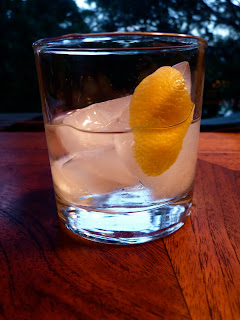I did not grill the halibut.
David Tanis, in his (recently mentioned) exquisite cookbook, A Platter of Figs and Other Recipes, says this is okay. Feel free to bake it, broil it, or pan-cook it. I threw it in the oven, but look forward to throwing it on the barbeque next time.
For some reason, I have a bit of grill-phobia. I don't know why, but I have trouble summoning up the strength to barbeque. Must be a mental block. I need to wrestle this problem to the ground, because I know I am missing out. Big time.
I've noticed a theme weaving through many of my cooking posts... simplicity. This surprises me a bit. I like more complicated cooking, and used to do a good deal more of it, but these days Fe is taking up even more of my time and energy. I tend to seek out recipes and dishes that don't require quite as much effort. I'm sure that in time this too will begin to change.
In the meantime, this halibut is fantastic. These are spices that I don't typically use when I cook fish. Cumin, coriander, fennel seed, cloves, turmeric, and cayenne. I'm more of a tarragon, chervil, lemon zest, and chives kind of girl when it comes to fish.
I'm thrilled for the change. The subtle heat of the spices is brilliant with the thick, moist flesh of the halibut.

Just be sure that your halibut is very fresh and purchased from a reputable fish monger or grocery store. I gave the new fish wholesaler near our home a shot, and I was very disappointed with the quality of the halibut. That being said, this recipe still managed to shine.
The slivered mint that you scatter over the fish gives a fresh contrast to the fish, as does the yogurt sauce.
The raita-like sauce also carries contrasts within itself. Cool, thick, whole-milk yogurt is refreshing against the warmth of the fish and its spices, but don't let it fool you. It has its own punch from the mustard seeds, garlic, ginger and serrano chile.
I love the sauce. I can't stop spooning it over the fish. Tanis recommends using it as a dressing for cucumber salad. I will certainly try this in the near future. Perfect summer fare.

I halved the recipe, because A. and I were dining alone. We still have enough for another meal. I served the fish with roasted yellow potatoes tossed with green garlic and thyme picked from the garden that Fe and I have been tending, along with steamed brussels sprouts and butter.
(And holy mackerel! I've learned something new. It's brussels not brussel. Yet another embarrassing confession!)
Most of the recipes in A Platter of Figs and Other Recipes serve eight, so I am anxious to use this cookbook to kick-start our summer entertaining. We have fallen far far behind.
Grilled Halibut with Indian Spices and Yellow Tomatoes
2 teaspoons cumin seeds
2 teaspoons coriander seeds
2 teaspoons fennel seeds
6 cloves
1 tablespoon turmeric
1/2 teaspoon cayenne
8 halibut fillets or steaks, about 6 ounces each
salt and pepper
2 tablespoons olive oil
8 yellow tomatoes, cut into small wedges
yogurt sauce (recipe follows)
a handful of mint leaves
In a dry cast-iron pan (or other heavy skillet), toast the cumin, coriander, fennel, and cloves over medium heat until fragrant, about 2 minutes. Transfer to a spice grinder or mortar and grind fine (Note to self: Get another grinder! Cleaning out coffee to make dinner or cleaning out spices to make coffee is a pain in the arse!). Put the ground spices in a small bowl and add the turmeric and cayenne.
Place the halibut on a baking sheet and season with salt and pepper. Drizzle with the olive oil. Sprinkle the spice mixture over the fish, then massage it in. Cover and refrigerate for up to several hours. Bring the fish to room temperature before cooking.
Prepare a fire in a charcoal grill. Grill the halibut over medium coals for 3 minutes per side, until just opaque throughout (the fish can also be cooked under the broiler, baked in a hot oven, or pan-cooked).
Arrange the halibut on a large platter and surround with the yellow tomatoes. Sprinkle the tomatoes lightly with salt. Spoon a little yogurt sauce onto each portion and pass the rest at the table. Sliver the mint leaves with a sharp knife and scatter over the platter.
Yogurt Sauce
3 cups whole-milk yogurt
1 tablespoon olive oil
2 teaspoons mustard seeds
2 teaspoons cumin seeds
3 garlic cloves, finely chopped
2 teaspoons grated ginger
1 serrano chile, finely chopped
salt and pepper
Put the yogurt in a bowl. In a small frying pan, heat the olive oil over a medium flame. Add the mustard and cumin seeds. When the seeds begin to pop, add the garlic and let it sizzle, without browning, about 10 seconds or so.
Scrape the contents of the pan into the yogurt. Stir in the ginger and chile. Season with salt and pepper. The sauce will keep in the fridge for a day or two.
































